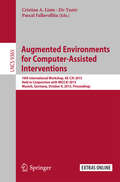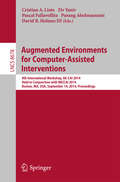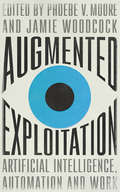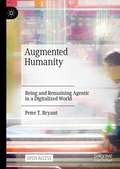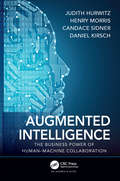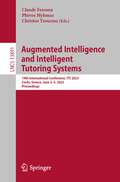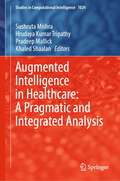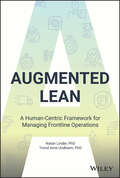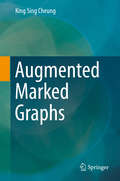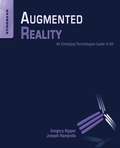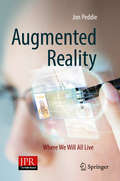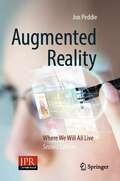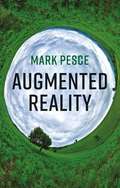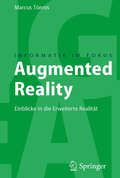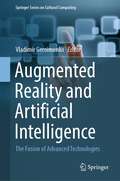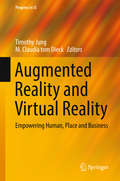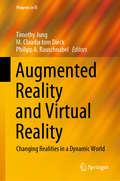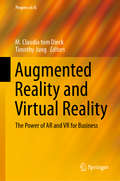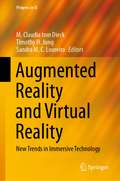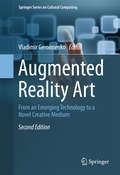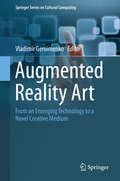- Table View
- List View
Augmented Environments for Computer-Assisted Interventions: 10th International Workshop, AE-CAI 2015, Held in Conjunction with MICCAI 2015, Munich, Germany, October 9, 2015. Proceedings (Lecture Notes in Computer Science #9365)
by Cristian A Linte Ziv Yaniv Pascal FallavollitaThis book constitutes the refereed proceedings of the 10th International Workshop on Augmented Environments for Computer-Assisted Interventions, held in conjunction with MICCAI 2015, in Munich, Germany in October 2015. The 15 revised full papers presented were carefully reviewed and selected from 21 submissions. The objective of the AE-CAI workshop was to attract scientific contributions that offer solutions to the technical problems in the area of augmented and virtual environments for computer-assisted interventions, and to provide a venue for dissemination of papers describing both complete systems and clinical applications.
Augmented Environments for Computer-Assisted Interventions: 9th International Workshop, AE-CAI 2014, Held in Conjunction with MICCAI 2014, Boston, MA, USA, September 14, 2014, Proceedings (Lecture Notes in Computer Science #8678)
by Cristian A. Linte Ziv Yaniv Pascal Fallavollita Purang Abolmaesumi David Holmes IIIThis book constitutes the refereed proceedings of the 9th International Workshop on Augmented Environments for Computer-Assisted Interventions, held in conjunction with MICCAI 2014, in Boston, MA, USA in September 2014. The 15 revised full papers presented were carefully reviewed and selected from 23 submissions. The scope of the workshop spans the theoretical and practical aspects of augmented reality and visualization computer assisted intervention, interventional imaging, image-guided robotics, image-guided intervention, surgical planning and simulation, systematic extra- and intra-corporeal imaging modalities, general biological and neuroscience image computing, patient specific modeling, and medical image understanding.
Augmented Exploitation: Artificial Intelligence, Automation and Work (Wildcat)
by Phoebe V. Moore and Jamie WoodcockArtificial Intelligence is a seemingly neutral technology, but it is increasingly used to manage workforces and make decisions to hire and fire employees. Its proliferation in the workplace gives the impression of a fairer, more efficient system of management. A machine can't discriminate, after all. Augmented Exploitation explores the reality of the impact of AI on workers' lives. While the consensus is that AI is a completely new way of managing a workplace, the authors show that, on the contrary, AI is used as most technologies are used under capitalism: as a smokescreen that hides the deep exploitation of workers. Going beyond platform work and the gig economy, the authors explore emerging forms of algorithmic governance and AI-augmented apps that have been developed to utilise innovative ways to collect data about workers and consumers, as well as to keep wages and worker representation under control. They also show that workers are not taking this lying down, providing case studies of new and exciting form of resistance that are springing up across the globe.
Augmented Exploitation: Artificial Intelligence, Automation and Work (Wildcat)
Artificial Intelligence is a seemingly neutral technology, but it is increasingly used to manage workforces and make decisions to hire and fire employees. Its proliferation in the workplace gives the impression of a fairer, more efficient system of management. A machine can't discriminate, after all. Augmented Exploitation explores the reality of the impact of AI on workers' lives. While the consensus is that AI is a completely new way of managing a workplace, the authors show that, on the contrary, AI is used as most technologies are used under capitalism: as a smokescreen that hides the deep exploitation of workers. Going beyond platform work and the gig economy, the authors explore emerging forms of algorithmic governance and AI-augmented apps that have been developed to utilise innovative ways to collect data about workers and consumers, as well as to keep wages and worker representation under control. They also show that workers are not taking this lying down, providing case studies of new and exciting form of resistance that are springing up across the globe.
Augmented Humanity: Being and Remaining Agentic in a Digitalized World
by Peter T. BryantThis open access book will examine the implications of digitalization for the understanding of humanity, conceived as a community of intelligent agency. It addresses important topics across a range of social and behavioral theories and identifies a range of novel mechanisms and their social behavioral effects. Across the book, the author highlights the expansion of intelligent processing capability brought about by digitalization and the challenges this exposes for integrating artificial and human capabilities. It includes the altered effects of bounded rationality in problem solving and decision making; related changes in the perception of rationality, plus novel myopias and biases. It also seeks to address cognitive intersubjectivity, learning from performance and agentic self-generation; and the novel methods and patterns of reasoned thought which emerge in a digitalized world; and how these mechanisms will combine in making and remaking the world of human experience and understanding. This book examines the problematics and prospects for digitally augmented humanity. In doing so, it maps the terrain for a future science of augmented agency. It will have cross-disciplinary appeal to students and scholars of applied psychology, cognitive and behavioral science, organizational psychology and management, business, finance, and digital cultures and humanities.
Augmented Intelligence: The Business Power of Human–Machine Collaboration
by Judith Hurwitz Henry Morris Candace Sidner Daniel KirschThe AI revolution is moving at a breakneck speed. Organizations are beginning to invest in innovative ways to monetize their data through the use of artificial intelligence. Businesses need to understand the reality of AI. To be successful, it is imperative that organizations understand that augmented intelligence is the secret to success. Augmented Intelligence: The Business Power of Human–Machine Collaboration is about the process of combining human and machine intelligence. This book provides business leaders and AI data experts with an understanding of the value of augmented intelligence and its ability to help win competitive markets. This book focuses on the requirement to clearly manage the foundational data used for augmented intelligence. It focuses on the risks of improper data use and delves into the ethics and governance of data in the era of augmented intelligence. In this book, we explore the difference between weak augmentation that is based on automating well understood processes and strong augmentation that is designed to rethink business processes through the inclusion of data, AI and machine learning. What experts are saying about Augmented Intelligence "The book you are about to read is of great importance because we increasingly rely on machine learning and AI. Therefore, it is critical that we understand the ability to create an environment in which businesses can have the tools to understand data from a holistic perspective. What is imperative is to be able to make better decisions based on an understanding of the behavior and thinking of our customers so that we can take the best next action. This book provides a clear understanding of the impact of augmented intelligence on both society and business."—Tsvi Gal, Managing Director, Enterprise Technology and Services, Morgan Stanley "Our mission has always been to help clients apply AI to better predict and shape future outcomes, empower higher value work, and automate how work gets done. I have always said, ’AI will not replace managers, but managers who use AI will replace managers who don't.’ This book delves into the real value that AI promises, to augment existing human intelligence, and in the process, dispels some of the myths around AI and its intended purpose."—Rob Thomas, General Manager, Data and AI, IBM
Augmented Intelligence: The Business Power of Human–Machine Collaboration
by Judith Hurwitz Henry Morris Candace Sidner Daniel KirschThe AI revolution is moving at a breakneck speed. Organizations are beginning to invest in innovative ways to monetize their data through the use of artificial intelligence. Businesses need to understand the reality of AI. To be successful, it is imperative that organizations understand that augmented intelligence is the secret to success. Augmented Intelligence: The Business Power of Human–Machine Collaboration is about the process of combining human and machine intelligence. This book provides business leaders and AI data experts with an understanding of the value of augmented intelligence and its ability to help win competitive markets. This book focuses on the requirement to clearly manage the foundational data used for augmented intelligence. It focuses on the risks of improper data use and delves into the ethics and governance of data in the era of augmented intelligence. In this book, we explore the difference between weak augmentation that is based on automating well understood processes and strong augmentation that is designed to rethink business processes through the inclusion of data, AI and machine learning. What experts are saying about Augmented Intelligence "The book you are about to read is of great importance because we increasingly rely on machine learning and AI. Therefore, it is critical that we understand the ability to create an environment in which businesses can have the tools to understand data from a holistic perspective. What is imperative is to be able to make better decisions based on an understanding of the behavior and thinking of our customers so that we can take the best next action. This book provides a clear understanding of the impact of augmented intelligence on both society and business."—Tsvi Gal, Managing Director, Enterprise Technology and Services, Morgan Stanley "Our mission has always been to help clients apply AI to better predict and shape future outcomes, empower higher value work, and automate how work gets done. I have always said, ’AI will not replace managers, but managers who use AI will replace managers who don't.’ This book delves into the real value that AI promises, to augment existing human intelligence, and in the process, dispels some of the myths around AI and its intended purpose."—Rob Thomas, General Manager, Data and AI, IBM
Augmented Intelligence and Intelligent Tutoring Systems: 19th International Conference, ITS 2023, Corfu, Greece, June 2–5, 2023, Proceedings (Lecture Notes in Computer Science #13891)
by Claude Frasson Phivos Mylonas Christos TroussasThis book constitutes the refereed proceedings of the 19th International Conference on Augmented Intelligence and Intelligent Tutoring Systems, ITS 2023, held in Corfu, Greece, during June 2-5, 2023. The 41 full papers and 19 short papers presented in this book were carefully reviewed and selected from 84 submissions. The papers are divided into the following topical sections: augmented intelligence in tutoring systems; augmented intelligence in healthcare informatics; augmented intelligence in games, serious games and virtual reality; neural networks and data mining; augmented intelligence and metaverse; security, privacy and ethics in augmented intelligence; and applied natural language processing.
Augmented Intelligence in Healthcare: A Pragmatic and Integrated Analysis (Studies in Computational Intelligence #1024)
by Sushruta Mishra Hrudaya Kumar Tripathy Pradeep Mallick Khaled ShaalanThe book discusses how augmented intelligence can increase the efficiency and speed of diagnosis in healthcare organizations. The concept of augmented intelligence can reflect the enhanced capabilities of human decision-making in clinical settings when augmented with computation systems and methods. It includes real-life case studies highlighting impact of augmented intelligence in health care. The book offers a guided tour of computational intelligence algorithms, architecture design, and applications of learning in healthcare challenges. It presents a variety of techniques designed to represent, enhance, and empower multi-disciplinary and multi-institutional machine learning research in healthcare informatics. It also presents specific applications of augmented intelligence in health care, and architectural models and frameworks-based augmented solutions.
Augmented Lean: A Human-Centric Framework for Managing Frontline Operations
by Natan Linder Trond Arne UndheimExplore the real future of work in this expert tech implementation guide that goes beyond automation In Augmented Lean: A Human-Centric Framework for Managing Frontline Operations, serial startup founder Dr. Natan Linder and futurist podcaster Dr. Trond Arne Undheim deliver an urgent and incisive exploration of how to facilitate agile processes amongst a millennial workforce that already lives by many of its tenets. The book demonstrates how to abandon legacy industrial technology that is failing modern operations and hindering operational excellence and digital progress. As an executive and leader, you cannot fall prey to hyped-up notions of industry 4.0's factory of the future automation, artificial intelligence, internet of things, sensors, digital twins, and augmented reality fixing every problem. Instead, to truly reduce cognitive load, complexity, and frustrations in the workplace, we must build cyber-physical technologies so that humans remain at the center. Leaders must ensure that the technology they deploy at an industrial scale has fluid interfaces that demonstrably simplifies work and makes operations more flexible without introducing fear, uncertainty, or doubt. The authors provide: A step-by-step walkthrough of the Augmented Lean framework that shows readers when, how, and why to augment your workforce through cyber-physical principles that go beyond both Lean and Agile management practices Concrete strategies on how to scale these operational augmentation methods throughout your organization based on real-world case studies of operators in the trenches of manufacturing whose impact far outweighs their seniority in the corporate hierarchy Insightful advice for how to use the augmentation framework in small- and medium-sized enterprises where license and training costs are prohibitive when only using off-the-shelf industry 4.0 approaches A thoroughly practical playbook for augmenting your workforce with the latest cyber-physical adaptations to digital technologies, Augmented Lean provides you with the organizational-, process-, and management-level techniques you need to get the most out of your employees. In turn, as an operator, engineer, or industrial worker reading this book, you will become empowered to be a change agent through no-code interfaces instead of remaining a recipient of endless training demands and ever-increasing technological complexity. Augmented Lean will orient you towards the future with the most effective tools to cut through hype so you can instantly apply your learnings and be productive wherever you currently operate.
Augmented Lean: A Human-Centric Framework for Managing Frontline Operations
by Natan Linder Trond Arne UndheimExplore the real future of work in this expert tech implementation guide that goes beyond automation In Augmented Lean: A Human-Centric Framework for Managing Frontline Operations, serial startup founder Dr. Natan Linder and futurist podcaster Dr. Trond Arne Undheim deliver an urgent and incisive exploration of how to facilitate agile processes amongst a millennial workforce that already lives by many of its tenets. The book demonstrates how to abandon legacy industrial technology that is failing modern operations and hindering operational excellence and digital progress. As an executive and leader, you cannot fall prey to hyped-up notions of industry 4.0's factory of the future automation, artificial intelligence, internet of things, sensors, digital twins, and augmented reality fixing every problem. Instead, to truly reduce cognitive load, complexity, and frustrations in the workplace, we must build cyber-physical technologies so that humans remain at the center. Leaders must ensure that the technology they deploy at an industrial scale has fluid interfaces that demonstrably simplifies work and makes operations more flexible without introducing fear, uncertainty, or doubt. The authors provide: A step-by-step walkthrough of the Augmented Lean framework that shows readers when, how, and why to augment your workforce through cyber-physical principles that go beyond both Lean and Agile management practices Concrete strategies on how to scale these operational augmentation methods throughout your organization based on real-world case studies of operators in the trenches of manufacturing whose impact far outweighs their seniority in the corporate hierarchy Insightful advice for how to use the augmentation framework in small- and medium-sized enterprises where license and training costs are prohibitive when only using off-the-shelf industry 4.0 approaches A thoroughly practical playbook for augmenting your workforce with the latest cyber-physical adaptations to digital technologies, Augmented Lean provides you with the organizational-, process-, and management-level techniques you need to get the most out of your employees. In turn, as an operator, engineer, or industrial worker reading this book, you will become empowered to be a change agent through no-code interfaces instead of remaining a recipient of endless training demands and ever-increasing technological complexity. Augmented Lean will orient you towards the future with the most effective tools to cut through hype so you can instantly apply your learnings and be productive wherever you currently operate.
Augmented Marked Graphs
by King Sing CheungPetri nets are a formal and theoretically rich model for the modelling and analysis of systems. A subclass of Petri nets, augmented marked graphs possess a structure that is especially desirable for the modelling and analysis of systems with concurrent processes and shared resources.This monograph consists of three parts: Part I provides the conceptual background for readers who have no prior knowledge on Petri nets; Part II elaborates the theory of augmented marked graphs; finally, Part III discusses the application to system integration. The book is suitable as a first self-contained volume on augmented marked graphs, and will be useful to both researchers and practitioners in the fields of Petri nets and system integration.
Augmented Reality: An Emerging Technologies Guide to AR
by Greg Kipper Joseph RampollaWith the explosive growth in mobile phone usage and rapid rise in search engine technologies over the last decade, augmented reality (AR) is poised to be one of this decade's most disruptive technologies, as the information that is constantly flowing around us is brought into view, in real-time, through augmented reality. In this cutting-edge book, the authors outline and discuss never-before-published information about augmented reality and its capabilities. With coverage of mobile, desktop, developers, security, challenges, and gaming, this book gives you a comprehensive understanding of what augmented reality is, what it can do, what is in store for the future and most importantly: how to benefit from using AR in our lives and careers.Educates readers how best to use augmented reality regardless of industryProvides an in-depth understanding of AR and ideas ranging from new business applications to new crime fighting methods Includes actual examples and case studies from both private and government application
Augmented Reality: An Emerging Technologies Guide to AR
by Greg Kipper Joseph RampollaWith the explosive growth in mobile phone usage and rapid rise in search engine technologies over the last decade, augmented reality (AR) is poised to be one of this decade's most disruptive technologies, as the information that is constantly flowing around us is brought into view, in real-time, through augmented reality. In this cutting-edge book, the authors outline and discuss never-before-published information about augmented reality and its capabilities. With coverage of mobile, desktop, developers, security, challenges, and gaming, this book gives you a comprehensive understanding of what augmented reality is, what it can do, what is in store for the future and most importantly: how to benefit from using AR in our lives and careers.Educates readers how best to use augmented reality regardless of industryProvides an in-depth understanding of AR and ideas ranging from new business applications to new crime fighting methods Includes actual examples and case studies from both private and government application
Augmented Reality: Where We Will All Live
by Jon PeddieThis book provides an in-depth exploration of the field of augmented reality (AR) in its entirety and sets out to distinguish AR from other inter-related technologies like virtual reality (VR) and mixed reality (MR). The author presents AR from its initial philosophies and early developments, to its current technologies and its impact on our modern society, to its possible future developments; providing readers with the tools to understand issues relating to defining, building, and using our perception of what is represented in our perceived reality, and ultimately how we assimilate and react to this information. Augmented Reality: Where We Will All Live can be used as a comprehensive guide to the field of AR and provides valuable insights for technologists, marketers, business managers, educators and academics who are interested in the field of augmented reality; its concepts, history, practices and the science behind this rapidly advancing field of research and development.
Augmented Reality: Where We Will All Live
by Jon PeddieThis book provides an in-depth exploration of the field of augmented reality (AR) in its entirety and sets out to distinguish AR from other inter-related technologies like virtual reality (VR), mixed reality (MR) and extended reality (XR). The author presents AR from its initial philosophies and early developments, and in this updated 2nd edition discusses the latest advances and the ramifications they bring and the impact they have on modern society. He examines the new companies that have entered the field and those that have failed or were acquired giving a complete history of AR progress. He explores the possible future developments providing readers with the tools to understand issues relating to defining, building, and using their perception of what is represented in their perceived reality, and ultimately how we assimilate and react to this information. In Augmented Reality: Where We Will All Live 2nd Edition, Jon Peddie has amassed and integrated a corpus of material that is finally in one place. It will serve as a comprehensive guide and provide valuable insights for technologists, marketers, business managers, educators and academics who are interested in the field of augmented reality, its concepts, history, practices, and the science behind this rapidly advancing field of research and development.
Augmented Reality: Unboxing Tech's Next Big Thing
by Mark PesceSlated as ‘the next big thing in tech’, augmented reality promises to take the screen out of our hands and wrap it around the world via ‘smart spectacles’. As a pervasive, invisible interface between the world and our senses, AR offers unparalleled capacity to reveal hidden digital depths, but it also comes at a cost to our privacy, our property, and our reality. In this crucial and provocative book, Mark Pesce draws on over thirty years’ experience to offer the first mainstream exploration of augmented reality. He discusses the exciting and beneficial features of AR as well as the issues and risks raised by this still-emerging technology – a technology that moulds us by shaping what we see and hear. Augmented Reality is essential reading for anyone interested in the growing influence of this impressive but deeply concerning technology. As the book reveals, reality - once augmented - will never be the same.
Augmented Reality: Einblicke in die Erweiterte Realität (Informatik im Fokus)
by Marcus TönnisDer Autor befasst sich mit der Überlagerung der realen Welt durch computergenerierte virtuelle Objekte. Die drei grundlegenden Bausteine dieser erweiterten Realität, Darstellung, Tracking und Benutzerinteraktion, werden Schritt für Schritt eingeführt und miteinander in Zusammenhang gebracht. Ein Überblick über Anwendungen in Forschung und Industrie liefert Anregungen für die Entwicklung eigener Systeme. Leser können den Stoff anhand zahlreicher Übungen vertiefen.
Augmented Reality and Artificial Intelligence: The Fusion of Advanced Technologies (Springer Series on Cultural Computing)
by Vladimir GeroimenkoThis book is the first research monograph that explores a new research field and practical applications produced by the combined use of two of the most advanced and powerful technologies available in today’s world – Artificial Intelligence (AI) and Augmented Reality (AR). It is written by a team of 50 researchers and practitioners from 16 countries, which has enabled a thorough coverage of emerging or previously unexplored subject areas. The authors consider practical, theoretical, and cultural aspects of “AI-powered AR” and “AR-enriched AI”, and their usage in a large variety of areas, such as education, medicine, healthcare, dentistry, pharmacy, active lifestyle, smart services, fashion, retail, recommender systems, and several others. Augmented Reality and Artificial Intelligence: The Fusion of Advanced Technologies is essential reading not only for researchers, practitioners and technology developers, but also for students (both graduates and undergraduates) and anyone who is interested in building a comprehensive understanding of the emerging fields of “intelligent augmented environments” and “artificial intelligence presented by augmented reality”.
Augmented Reality and Virtual Reality: Empowering Human, Place and Business (Progress in IS)
by Timothy Jung M. Claudia tom DieckThis volume provides the latest outcomes of augmented reality (AR) and virtual reality (VR) research conducted in various industries. It reveals how AR and VR are currently changing the business landscape, and how new innovations provide opportunities for businesses to offer their customers unique services and experiences. Collecting the proceedings of the International AR & VR Conference held in Manchester, UK, in February 2017, the book advances the state of the art in AR and VR technologies and their applications in various industries such as tourism, hospitality, events, fashion, entertainment, retail, education and the gaming industry. The papers presented here cover the most significant topics within the field of AR and VR for both researchers and practitioners, approaching them from a business and management perspective.
Augmented Reality and Virtual Reality: Changing Realities in a Dynamic World (Progress in IS)
by Timothy Jung M. Claudia tom Dieck Philipp A. RauschnabelThis book features the latest research in the area of immersive technologies, presented at the 5th International Augmented and Virtual Reality Conference, held in Munich, Germany in 2019. Bridging the gap between academia and industry, it presents the state of the art in augmented reality (AR) and virtual reality (VR) technologies and their applications in various industries such as marketing, education, healthcare, tourism, events, fashion, entertainment, retail and the gaming industry. The volume is a collection of research papers by prominent AR and VR scholars from around the globe. Covering the most significant topics in the field of augmented and virtual reality and providing the latest findings, it is of interest to academics and practitioners alike.
Augmented Reality and Virtual Reality: The Power of AR and VR for Business (Progress in IS)
by M. Claudia tom Dieck Timothy JungThis book presents a collection of the latest research in the area of immersive technologies, presented at the International Augmented and Virtual Reality Conference 2018 in Manchester, UK, and showcases how augmented reality (AR) and virtual reality (VR) are transforming the business landscape. Innovations in this field are seen as providing opportunities for businesses to offer their customers unique services and experiences. The papers gathered here advance the state of the art in AR/VR technologies and their applications in various industries such as healthcare, tourism, hospitality, events, fashion, entertainment, retail, education and gaming. The volume collects contributions by prominent computer and social sciences experts from around the globe. Addressing the most significant topics in the field of augmented and virtual reality and sharing the latest findings, it will be of interest to academics and practitioners alike.
Augmented Reality and Virtual Reality: New Trends in Immersive Technology (Progress in IS)
by M. Claudia tom Dieck Timothy H. Jung Sandra M. C. LoureiroThis book features the latest research in the area of immersive technologies, presented at the 6th International Augmented Reality and Virtual Reality Conference, held in online in 2020. Bridging the gap between academia and industry, it presents the state of the art in augmented reality (AR) and virtual reality (VR) technologies and their applications in various industries such as marketing, education, health care, tourism, events, fashion, entertainment, retail and the gaming industry.The book is a collection of research papers by prominent AR and VR scholars from around the globe. Covering the most significant topics in the field of augmented and virtual reality and providing the latest findings, it is of interest to academics and practitioners alike.
Augmented Reality Art: From an Emerging Technology to a Novel Creative Medium (Springer Series on Cultural Computing)
by Vladimir GeroimenkoThis is the second edition of the first ever book to explore the exciting new field of augmented reality art and its enabling technologies. The new edition has been thoroughly revised and updated, and contains 5 new chapters. As well as investigating augmented reality as a novel artistic medium the book covers cultural, social, spatial and cognitive facets of augmented reality art. Intended as a starting point for exploring this new fascinating area of research and creative practice it will be essential reading not only for artists, researchers and technology developers, but also for students (graduates and undergraduates) and all those interested in emerging augmented reality technology and its current and future applications in art.
Augmented Reality Art: From an Emerging Technology to a Novel Creative Medium (Springer Series on Cultural Computing)
by Vladimir GeroimenkoWritten by a team of world-renowned artists, researchers and practitioners - all pioneers in using augmented reality based creative works and installations as a new form of art - this is the first book to explore the exciting new field of augmented reality art and its enabling technologies. As well as investigating augmented reality as a novel artistic medium the book covers cultural, social, spatial and cognitive facets of augmented reality art. Intended as a starting point for exploring this new fascinating area of research and creative practice it will be essential reading not only for artists, researchers and technology developers, but also for students (graduates and undergraduates) and all those interested in emerging augmented reality technology and its current and future applications in art.
